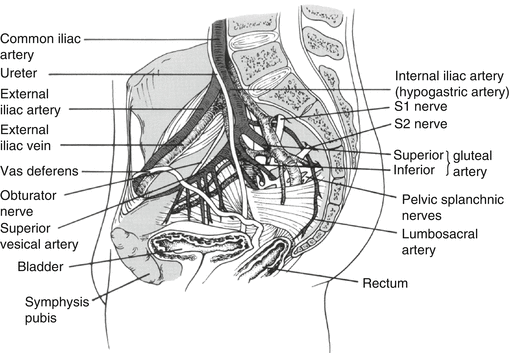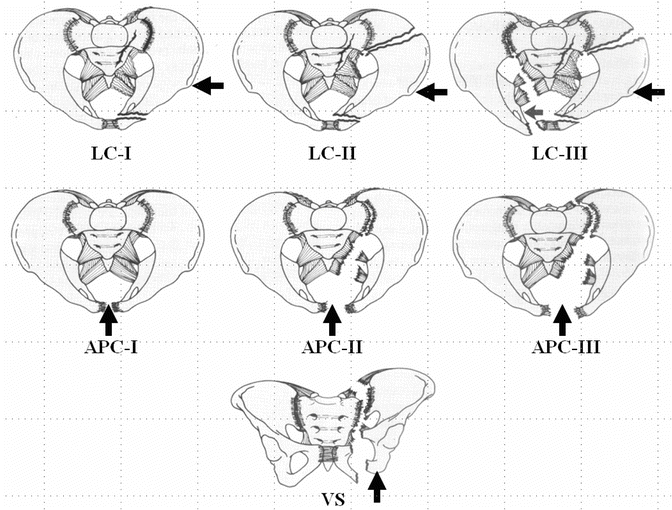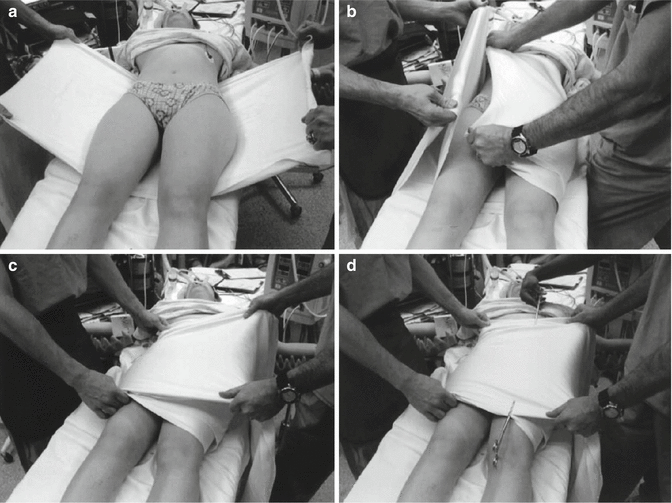Fig. 10.1
(a) Posterior view of the pelvis showing the strong posterior ligaments which provide critical stability of the pelvic ring. (b) Anterior view of the pelvis showing the important ligamentous structures that stabilize the pelvic ring (From: Tile [1])
Anatomically the pelvis structures can be separated into the true pelvis, located below the iliopectineal line (pelvic brim) and the false pelvis, located above the iliopectineal line. Numerous anatomical structures, including vascular supply for the buttocks and lower extremities, pass between the false and true pelvis. The true pelvis contains the floor of the pelvis along with the urethra, rectum, prostate, and vagina. The false pelvis surrounds the lower intraabdominal contents along with the iliacus muscle.
It is important to understand the location of major blood vessels which lie on the inner wall of the pelvis, since injury to these vessels is commonly associated with severe hemorrhage (Fig. 10.2). An understanding of pelvic anatomy will help the orthopedic surgeon recognize which fracture patterns are more likely to cause direct damage to major vessels and result in significant bleeding. The common iliac artery divides into the external and internal branches. The external iliac artery exits the pelvis anteriorly over the pelvic brim to become the femoral artery. The internal iliac artery lies over the pelvic brim and courses anterior and in close proximity to the sacroiliac joint. The posterior branches of the internal iliac artery include the iliolumbar, superior gluteal, and lateral sacral arteries. The superior gluteal artery, which is the largest branch of the internal iliac artery, courses across the sacroiliac joint in the true pelvis and exits through the greater sciatic notch to supply the gluteus medius, gluteus minimus, and tensor fascia lata muscles. It is the most commonly injured vessel in pelvic fractures with posterior ring disruptions. Anterior branches of the internal iliac artery include the obturator, umbilical, vesical, pudendal, inferior gluteal, rectal, and hemorrhoidal arteries. The inferior gluteal artery exits the pelvis through greater sciatic notch inferior to the piriformis and supplies the gluteus maximus. The pudendal and obturator arteries are adjacent to the pubic rami. In addition to the arteries, there is an associated large venous plexus which drains into the internal iliac vein. Injury to this venous plexus is the major source of hemorrhage in most pelvic fractures.


Fig. 10.2
Internal aspect of the pelvis showing the major blood vessels that lie on the inner wall of the pelvis (From Kellam and Browner [2]; Fig. 31.6)
The neural structures that traverse the pelvis can also be injured in displaced pelvic fractures, leading to long-term morbidity. The sciatic nerve is formed by roots from the lumbosacral plexus (L4, L5, S1, S2, S3) and exits the pelvis deep to the piriformis muscle. The lumbosacral trunk is formed from the anterior rami of L4 and L5, and it crosses anterior to the sacral ala and SI joint. Fractures of sacral ala or dislocations of SI joint are most likely to injure the lumbosacral trunk. Typical displacement patterns in posterior pelvic fractures include cranial and posterior displacement of the hemipelvis. This may actually decrease the tension on the nerve roots exiting the pelvis posteriorly. More concerning are pelvic injuries with anterior (and caudal) displacement of the hemipelvis, as these displacement patterns potentially put the nerve roots on continued and significant stretch. The L5 nerve root exits below the L5 transverse process and crosses the sacral ala approximately 2 cm medial to the sacroiliac joint. It may be injured in SI joint disruptions and during anterior surgical approaches to the SI joint.
Significant anterior ring disruption can also damage the urethra and/or bladder. The female urethra is short and not rigidly fixed to the pubis or pelvic floor. Since it is more mobile it is less susceptible to injury from shear forces associated with pelvic fractures. The male urethra is less mobile and is making it more susceptible to injury in pelvic fractures. Stricture is the most common long-term complication observed in male patients who have sustained a urethral injury, but impotence may also occur in 25–47 % of patients with urethral rupture and is likely due to associated injury of the parasympathetic nerves (S2–S4). In males the bladder neck is attached to the pubis by puboprostatic ligaments and is contiguous with prostate, whereas in females the bladder lies on pubococcygeal portion of levator ani muscles. The superior and upper posterior portion of the bladder is covered by peritoneum, while the remainder of the bladder is extraperitoneal and covered with loose areolar tissue. Bladder injuries may be caused by a variety of mechanisms including bony spicules from the pubic rami fractures, blunt force injuries causing rupture, or shearing injuries. Intraperitoneal bladder ruptures require operative repair. Extraperitoneal bladder ruptures can usually be managed nonoperatively unless there is a bony spicule invading the bladder. Nonoperative management consists of catheter drainage and broad spectrum antibiotics. Most bladder injuries heal by 3–6 weeks, and a cystogram is obtained prior to catheter removal to confirm bladder healing.
10.2 Classification
Classification systems are useful to aid in decision making and treatment following high-energy pelvic fractures [3, 4]. Several pelvic fracture classification systems have been developed including the Pennal, Letournel, Bucholz, Tile, and Young and Burgess. The two classification systems which are commonly used are the Tile classification and the Young and Burgess classification.
The Tile classification primarily describes pelvic instability based on the anterior and posterior injury pattern(s) [5, 6]. Injuries are divided into three broad categories using an ABC classification similar to the AO/OTA classification system. These three main categories are further divided into specific subtypes. Type A injuries are stable pelvic fractures. Type B injuries are rotationally unstable, but vertically stable fractures. Type C injuries are both rotationally and vertically unstable (Table 10.1).
Table 10.1
Tile classification system of pelvic fractures
Type | Description | Mechanism |
|---|---|---|
Stable posterior ring A1 | Avulsion fractures (e.g., ASIS, AIIS, or ischial tuberosity) |  |
A2 | Stable iliac wing fracture Minimal fracture displacement of the pelvic ring with intact ligaments (e.g., pubic rami and compression of the sacroiliac joint) |  |
A3 | Isolated anterior ring injuries (e.g., pubic ramus) |  |
Rotationally unstable & vertically stable B1 | “Open book” injuries that cause disruption of the symphysis pubis +/− the sacrospinous and anterior sacroiliac ligaments |  |
B2 | Lateral compression injury causing anterior injury to pubic rami and impaction rather than disruption of the posterior ligament complex B2 has ipsilateral anterior and posterior injuries |  |
B3 | Lateral compression with associated anterior and posterior injuries on the contralateral side |  |
Vertical shear C1 | Unilateral injury with further subdivision according to the nature of posterior injury C1-1 iliac fracture C1-2 sacroiliac dislocation or fracture dislocation C1-3 sacral fracture |  |
C2 | Bilateral injury with one side stable and the other unstable |  |
C3 | Bilateral injury with both sides being unstable |  |
The Young and Burgess classification is primarily a mechanistic system based on the perceived applied force necessary to produce the injury pattern observed. This classification system should alert the surgeon to common associated injuries, the resuscitation needs of the patient, and may direct clinical care. The pelvic fracture mechanism is categorized into anterior posterior compression (APC), lateral compression (LC), vertical shear (VS), and combined mechanism (CM). Within each category, subtypes indicate the severity of injury (Table 10.2 and Fig. 10.3).

Table 10.2
Young and Burgess classification
Type | Description | Mechanism |
|---|---|---|
Anterior posterior compression (APC) APC I | Slight widening if the symphysis pubis (<2.5 cm) Intact posterior ligamentous complex |  |
APC II | Widening of the symphysis pubis (>2.5 cm) Anterior widening of the sacroiliac joint (e.g., anterior sacroiliac, sacrotuberous, and sacrospinous ligaments are disrupted) Posterior sacroiliac ligaments are intact |  |
APC III | Complete disruption of the ipsilateral ligaments (APC II plus posterior sacroiliac ligaments) Hemipelvis instability both rotationally and vertically |  |
Lateral compression (LC) LC I | Oblique pubic ramus fracture Ipsilateral sacral compression fracture Caused by a direct lateral force |  |
LC II | Rami fracture Sacral crush injury with either posterior sacroiliac joint disruption or iliac wing fracture Crescent fracture (posterior fracture pattern) Caused by a anteriorly directed lateral force vs. LC I |  |
LC III | Windswept pelvis (ipsilateral lateral compression and contralateral APC) LC II pattern with continuation of force to the opposite hemipelvis resulting in an external rotation injury of the opposite hemipelvis |  |
Vertical shear (VS) | Disruption of all the ligamentous structures of the hemipelvis Caused by a vertically directed force Sacroiliac joint disruption or vertical sacral fracture |  |
Combined mechanism (CM) | High-energy pelvic injuries usually involve fractures caused by more than a single force vector May have combined components of any of the above fracture patterns |

Fig. 10.3
The Young-Burgess classification of pelvic fracture. LC lateral compression type pattern, APC anteroposterior compression type pattern, VS vertical shear type pattern. The arrow in each panel indicates the direction of force producing the fracture pattern (From Kellam and Browner [2]; Fig. 31.12)
The Young and Burgess pelvic fracture classification has been found to correlate with the pattern of organ injury, resuscitative requirements, and mortality [7, 8]. A rise in mortality has been shown as the APC grade increases, and the APC-III pattern of injuries has been correlated with the greatest 24-h fluid resuscitation requirements.
In a series of 210 consecutive patients with pelvic fractures, Burgess and colleagues reported that transfusion requirements for patients with APC injuries averaged 14.8 units, compared to a mean of 3.6 units for patients with LC injuries, and 5 units for patients with combined mechanism injuries [7]. The overall mortality rate in this series was 8.6 %. A higher mortality rate was seen in the APC (20 %) and CM patterns (18 %), compared to the LC (7 %) and VS (0 %) patterns. Burgess and colleagues noted that exsanguination from pelvic injuries was rare in the lateral compression pattern in which mortality was typically due to other injuries, most commonly a severe closed head injury.
In a study of 343 trauma patients with pelvic fractures, investigators found that as the APC type increased from I to III there was an increasing percentage of injury to the spleen, liver, and bowel [8]. In addition there was an increasing incidence of pelvic vascular injury, retroperitoneal hematoma, shock, sepsis, and acute respiratory distress syndrome. Similarly, as the LC type increased from I to III the authors found an increased incidence of pelvic vascular injury, retroperitoneal hematoma, shock, and 24 h volume needs. Organ injury patterns and mortality in patients with vertical shear injuries were similar to those with high grade APC injuries. Patients with combined mechanisms of injury had an associated injury pattern similar to the lower grades of APC and LC injuries. The pattern of injury in the APC-III was correlated with the greatest 24 h fluid requirements. The investigators also reported major differences in the causes of death between patients with LC patterns compared to APC patterns. Brain injury was the major cause of death in LC injuries, while in APC patterns the most common causes of mortality were shock, sepsis, and ARDS related to massive torso forces.
10.3 Physical Examination
The orthopedic examination of the pelvis should be methodical and complete. An associated limb deformity (shortening or rotation) may be indicative of a pelvic injury with displacement. Hip dislocations should be reduced urgently with a complete neurovascular exam performed before and after reduction. The skin about the entire pelvis should be examined to ensure that there are no associated open wounds. This includes special attention to the perineum and gluteal folds where open fractures frequently occur. A digital rectal examination is required to detect rectal injury and open injuries in this location. In women, a vaginal examination should be performed to rule out an open injury. Manual palpation of the pelvis should be carefully performed and repeated examinations should be avoided.
The potential of an associated urethral injury should be considered in all pelvic fractures with significant anterior ring disruption (APC-II and APC-III type patterns). Signs of potential urethral injury include [9] inability to void despite a full bladder [10], blood at urethral meatus [11], high riding or abnormally mobile prostate [12], elevated bladder on intravenous pyelogram (IVP). However, the absence of meatal blood or a high riding prostate does not rule out urethral injury. If there is a high index of suspicion for genitourinary injury early contrast studies are required. A retrograde urethrogram should be obtained to rule out urethral injury prior to insertion of a urinary catheter, since passing a urinary catheter in the presence of a urethral injury can cause additional iatrogenic injury. Additionally, a cystogram with/without CT can be obtained to rule out bladder injury. However, one should ensure minimal or no contrast dye is remaining in the bladder to prevent problems with intraoperative visualization in patients requiring boney operative intervention.
10.4 Emergent Treatment/Bony Stabilization
It is uncommon for bleeding from a pelvic fracture to be the sole source of blood loss in the multi-injured patient. In fact, massive bleeding from a pelvic fracture alone is uncommon. Nevertheless, pelvic fractures must be considered as a potential source of major bleeding in the hemodynamically unstable patient, particularly when initial attempts to control bleeding from other sources fail to stabilize the patient. Provisional stabilization of the pelvic fracture should occur immediately during the patient’s initial evaluation and resuscitation using one of the methods described in the following section.
10.4.1 Pelvic Binders
Circumferential pelvic compression can be easily achieved in the prehospital setting with some form of commercially available pelvic binders, providing early and beneficial pelvic stabilization during transport and resuscitation. In lieu of a commercial binder, a folded sheet wrapped circumferentially around the pelvis can also be used [13] (Fig. 10.4). The use of pelvic binders has been shown to reduce transfusion requirements, length of hospital stay, and mortality in patients with APC injuries [14]. External rotation of the legs is commonly seen in displaced pelvic fractures and forces acting through the hip joint may contribute to pelvic deformity. Correction of lower extremity external rotation can be easily achieved by taping the feet and knees together, which may improve the pelvic reduction provided through use of a pelvic binder.


Fig. 10.4



Application of circumferential pelvic antishock sheeting. (a) A sheet is folded smoothly to a width of approximately 2 feet and placed beneath the patient’s pelvis. (b, c) The ends of the sheet are crossed in an overlapping manner and pulled taut. (d) Clamps are placed proximally and distally to secure the sheet in position (From Routt et al. [13])

Full access? Get Clinical Tree







